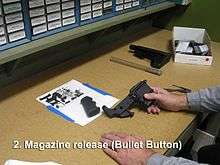Bullet button

A bullet button is a device used to remove a magazine in a semiautomatic rifle, replacing the magazine release with a block which forces the user to remove the magazine by using a tool as opposed to his or her finger. This allows rifles to comply with California's firearms law. The name came about due to a 1999 California State law which said that a "bullet or ammunition cartridge is considered a tool."[1]
History
After certain rifles with detachable magazines and certain other features were classified as assault weapons under California State law, gun owners and manufacturers sought various ways to obtain certain styles of rifles similar to those determined to be assault weapons. One of the most common modifications is the use of a part known as a bullet button, which modifies a rifle so that the magazine is not removable without the use of a tool (a bullet was defined as a tool per state law).[1] The bullet button was invented and named by Darin Prince of California in January 2007. Prince also holds the US Trademark for Bullet Button USPTO trademark registration number 77663672.[2]
The bullet button recesses a small release within a block that replaces the magazine release. The recessed button to detach the magazine cannot be pressed by the shooter's finger. Firearms with this feature no longer have a "detachable magazine" under California's assault weapons definition, and therefore may be exempt depending on the other requirements.
The 2012 court case Haynie v Pleasanton validated that a bullet button is legal and rifles that have one installed are not considered assault weapons.[3]
Many tools have been devised to make it easier and faster to release a magazine from a rifle, as California law states that the user must use an external tool not attached to the rifle. A popular tool, the "magnet button," sticks on the bullet button.
California Senator Leland Yee, who was later convicted of arms trafficking, attempted to have the bullet button outlawed in California, as did U.S. Senator Dianne Feinstein at the federal level;[4] both attempts failed.[5][6] On April 20, 2016, California state lawmakers gave initial approval of a bill that prohibited the sale of rifles with the bullet button. This was in response to a December 2015 terrorist attack in San Bernardino, California, despite the fact that the perpetrators, Rizwan Farook and Tashfeen Malik, used rifles that had their bullet buttons illegally removed.[7]
References
- 1 2 "Department of Justice Regulations for Assault Weapons and Large Capacity Magazines" (PDF).
- ↑ "Trademark Status & Document Retrieval". tsdr.uspto.gov. Retrieved 2016-07-25.
- ↑ "Haynie v Pleasanton docket". March 25, 2010. Retrieved January 6, 2012.
- ↑ Feinstein, Dianne (January 24, 2013). "Assault Weapons Ban of 2013". senate.gov. Retrieved May 25, 2014.
- ↑ Newcomb, Alyssa (March 27, 2014). "California State Sen. Leland Yee Indicted on Weapons Charges, Was Gun Control Crusader". ABC News. Retrieved May 18, 2014.
- ↑ "Bullet Button Used To Get Around California Gun Laws". CBS News. May 1, 2012.
- ↑ McGreevy, Patrick (April 20, 2016). "Lawmakers advance gun control measures in response to San Bernardino massacre". The Los Angeles Times. Retrieved April 20, 2016.
Further reading
- "California Law Enforcement Unclear On Legality Of 'Bullet Button'". CBS Local Media. June 21, 2012. Retrieved May 25, 2014.
- Dinzeo, Maria (March 7, 2014). "Two California Gun Laws Kept Alive This Week". Courthouse News Service. Retrieved May 25, 2014.
External links
 Media related to Bullet buttons at Wikimedia Commons
Media related to Bullet buttons at Wikimedia Commons